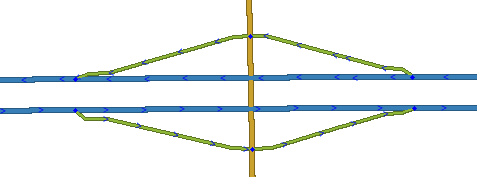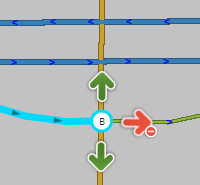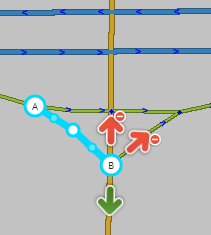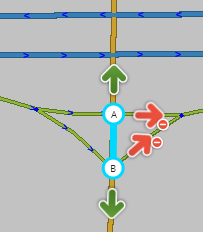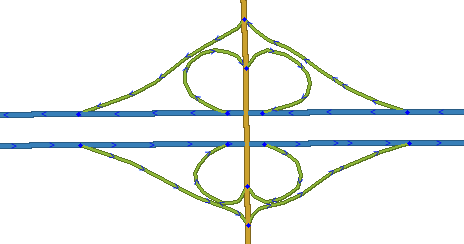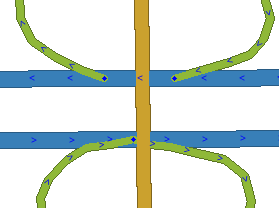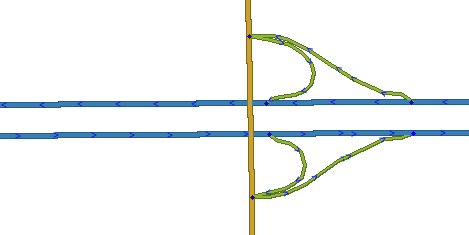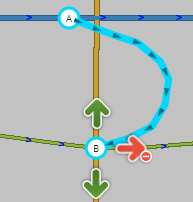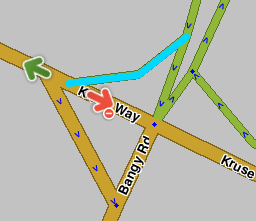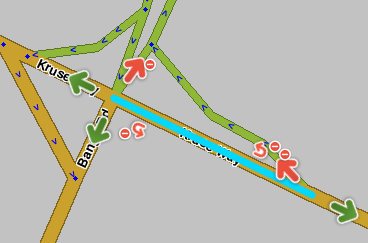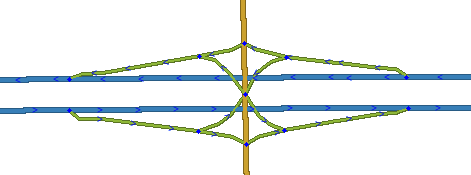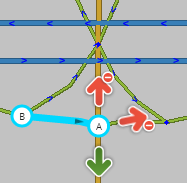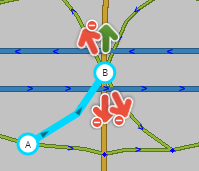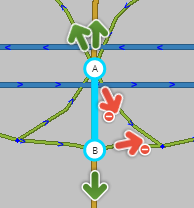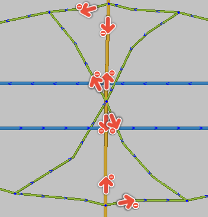(→Collector/Distributor Lanes: big changes) |
Kentsmith9 (talk | contribs) (→Complex collector/distributor exit systems: reduce image) |
||
| Line 129: | Line 129: | ||
==== Complex collector/distributor exit systems ==== | ==== Complex collector/distributor exit systems ==== | ||
[[Image:Collector-distributor-exit.png|thumb|right| | [[Image:Collector-distributor-exit.png|thumb|right|450px|Collector-distributor lanes used in a group of exits on I-81 in Christiansburg, Virginia (Exits 118A-B-C)]] | ||
Where collector/distributor lanes are used as part of an exit or group of exits, use the {{Ramp}} type for the collector/distributor lanes. Name the ramp segments as you would any other ramp segment. | Where collector/distributor lanes are used as part of an exit or group of exits, use the {{Ramp}} type for the collector/distributor lanes. Name the ramp segments as you would any other ramp segment. | ||
{{clear}} | {{clear}} | ||
=== Local-express lanes === | === Local-express lanes === | ||
Revision as of 01:52, 4 April 2014
When two roads meet in a limited access interchange (any situation where travel between grade separated roads is facilitated by ramps or slip roads alone), extra care must be taken.
If an exit ramp lines up with an entrance ramp, care must be taken to restrict the straight through direction to prevent "ramp-to-ramp routing" where the routing engine may try to take a shortcut from the Freeway, to the exit ramp, to the entrance ramp, and back to the Freeway instead of staying on the Freeway. That motion is inefficient and may be illegal in certain jurisdictions.
Care must be taken to not enable all turns in any situation where ramps meet unless all possible flows of traffic have been considered!
We also have to pay attention to the elevation of the road segments since there will typically be many bridges and overpasses for any limited access interchange. If two roads cross without connecting, their elevations must be different.
The following sections discuss some of the common Interchange designs. Note that some Interchanges may be a hybrid of these basic designs where one side or quadrant of the interchange may differ from the others.
Before reading through this article, be sure to fully understand the information in the Junction Style Guide.
Diamond Interchange
See also: Diamond Interchange article on Wikipedia
Common in wide open spaces where land acquisition and geography are not concerns, this Interchange design has ramps equally distributed across all 4 quadrants.
In the simplest form, this can be represented as single connections from the ramps to the surface street.
Note: Be sure to restrict the straight through motion from the exit ramp onto the entrance ramp on the other side of the road. This will prevent the routing server from trying to route someone off the freeway just to get back on it. Even though it may be a legal direction for a vehicle, turn restrictions are only for controlling routing directions.
If the ramps connect to the surface street at multiple points, ramp-to-ramp routing should be avoided as well as illegal turns which should use another ramp. Review the section How complex should ramps be? in the Junction Style Guide for more details on this topic.
First we see the turns that must be restricted for the exit ramps:
Then we see what must be restricted for the entrance ramps:
Note on elevations: The single surface street segment between the inner most ramps should be either raised or lowered in relation to the freeway segments depending on the actual geography at the interchange.
Cloverleaf Interchange
See also: Cloverleaf Interchange article on Wikipedia
In a Cloverleaf Interchange, left turns are eliminated from all movements between the Freeway and the surface street. First check the exit ramps.
Then check the entrance ramps for illegal turns.
The connections to the Freeway segments may be treated in two ways:
- (top) we can have the inner entrance and exit ramps have their own junction nodes with the Freeway. Do NOT use this approach if there are Collector/Distributor Lanes (or a similar situation) involved.
- (bottom) we can have the entrance and exit ramps share a single junction node with the Freeway. This allows us to eliminate the very short Freeway segment that may exist between the inner entrance and exit ramps.
It is best to offset this shared junction onto the Entrance ramp side of the surface street. This prevents the junction from accidentally being connected to the surface street or looking like it does. We favor the Entrance ramp side, because this would result in a slightly earlier exit instruction which is of course preferred over a late exit instruction.
The determining factor of which design to use will partly depend on the actual size and scale of the specific interchange and if there is a Collector/Distributor involved.
Note on Elevation: The single surface street segment between the inner most ramps should be either raised or lowered in relation to the freeway segments depending on the actual geography at the interchange.
Folded Diamond
See also: Discussion of Folded Diamonds and A2/B2 Partial Cloverleafs on the Partial Cloverleaf Interchange article on Wikipedia
Geography or property ownership may prevent the ability for an interchange to be constructed with all ramps evenly distributed across the 4 quadrants of the interchange. When only two quadrants are used, it is typically called a Folded Diamond (basically a sub-type of a Partial Cloverleaf Interchange). The ramps may be all on one side (as in the examples in this section) or they may be located in diagonally opposed quadrants.
The unique situation presented by the Folded Diamond arrangement is having both Entrance and Exit ramps terminating on the same side of the surface street. Ideally both ramps should terminate on the same junction node to permit us to easily restrict the illegal and usually impossible ramp-to-ramp movement.
Like with a basic Diamond Interchange, often it will be necessary to represent the ramps making multiple connections to the surface street. Be sure to read the article How complex should ramps be? in the Junction Style Guide.
Restrict all non-permitted turns.
Note on Elevation: Similar to a basic Diamond interchange, in most cases only the segment of the surface street that crosses the Freeway segments will need to be adjusted up or down.
Single Point Urban Interchange (SPUI)
See also: Single Point Urban Interchange article on Wikipedia
A SPUI is a very space and flow efficient design, but it takes extra attention to ensure the turns are correct. And as the name indicates, ideally there should be a single junction in the center. You may need to tweak the geometry of segments a bit off of alignment from the real physical world, but it should be minor if the interchange is a true SPUI.
The outer branches of the exit ramps are very much like in the case of a diamond interchange:
Where things get complicated is the inner branches leading to the Single Point. You need to avoid ramp-to-ramp in two directions and a reverse flow turn. Note: The ramp-to-ramp motion to facilitate a U-Turn (the top left arrow in the image below) may or may not be allowed depending on the specific interchange. Please validate this turn.
Luckily the entrance ramp restrictions are similar to the diamond interchange:
If you were to look at all the restricted turns at once, you may get the false impression that something is very wrong. But as you now know, a SPUI has almost as many restricted turns as allowed ones.
Note on Elevation: The two surface street segments (between the outer ramps and connected to the Single Point) and the 4 ramp segments connected to the single point should all be the same level, either one higher or one lower than the elevation of the freeway segments above/below the single point.
Collector/distributor lanes
These are lanes parallel to, but physically separated from, the lanes of a Freeway that serve to keep merging traffic out of the flow of through traffic on the mainline Freeway.
Collector/distributor lanes serve as either:
- some of the ramps in an exit or group of exits, or
- local lanes in configurations with local-express lanes.
Collector/distributor exits
Some exit configurations make use of collector/distributor lanes to separate lower-speed merging traffic from high-speed through traffic. This is often used in cloverleaf interchanges and in groups of nearby exits.
Collector/distributor cloverleaf
This is a cloverleaf interchange that is connected to a collector/distributor instead of directly to the main roadway. Map collector-distributor cloverleaf ramps as you would any other ramp.
The detour prevention mechanism will prevent Waze from routing users onto the collector-distributor and back onto the freeway.
Complex collector/distributor exit systems

Where collector/distributor lanes are used as part of an exit or group of exits, use the Ramp type for the collector/distributor lanes. Name the ramp segments as you would any other ramp segment.
Local-express lanes

Local-express lanes are similar to collector/distributor exits, but on a larger scale. While collector/distributor exits typically have an exit number or numbers, local-express names typically share the same name, differentiated by "Local" for the collector/distributor lanes and "Express" for the thru lanes.
Where collector/distributor lanes are used as part of a local-express lane configuration,
- use the same type (most likely Freeway ) for the Local lanes as is used for the Express lanes, and
- name the road as it is signed: typically "[Name] Local [Direction]": for example, "I-96 Local W" (and "I-96 Express W" for the Express lanes).
See also
Review the Wikipedia article on Road Interchanges for further information on this topic.
